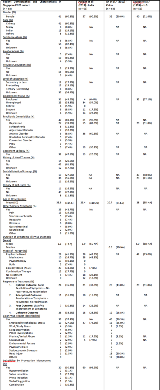Comparison of Psychogenic Nonepileptic Seizures in Singapore With the Worldwide Experience
Abstract number :
2.412
Submission category :
16. Epidemiology
Year :
2018
Submission ID :
502580
Source :
www.aesnet.org
Presentation date :
12/2/2018 4:04:48 PM
Published date :
Nov 5, 2018, 18:00 PM
Authors :
Gaurav D. Singh, National University of Singapore; Nigel CK. Tan, National Neuroscience Institute; Chao Li Chang, National Neuroscience Institute; and Yee-Leng Tan, National Neuroscience Institute
Rationale: Psychogenic nonepileptic seizures (PNES) are a worldwide phenomenon, yet there are scarce data on this condition from Southeast Asia. We aimed to describe the demographics, comorbidities, and prognosis of PNES patients in our tertiary institution over a 10-year period, with comparative data from India,1China2and U.S.3centers. Methods: We recruited 68 patients, by retrospectively identifying them from an EEG database (2007-2017) using the search terms “PNES” and “pseudo-seizures”. Treatment details were extracted from case records, after ethics approval was obtained from our institutional research board. The diagnosis of PNES was made based on a history consistent with PNES and the simultaneous recording of a typical event on video-EEG without epileptiform activity before, during, and after the ictus. In cases (n= 19) where events were not captured on video-EEG, PNES diagnosis was also accepted if events with semiological features typical of PNES were witnessed by a clinician. Results: Demographics and clinical characteristics of our PNES cohort are shown in Table 1 alongside comparative data. Similar to worldwide studies, there was a preponderance of females (60.3%). Psychiatric comorbidities were common (69.1%), especially depression and other mood disorders, and schizophrenia. Suicidal ideation was reported in 19 (27.9%) patients; 11 (16.2%) having committed acts of deliberate self-harm. Slightly more than half (57.4%) of our PNES population had identifiable triggers, with emotional stress being most commonly reported. Similar to the Chinese (An et al)2study, our rate of physical / sexual abuse was comparatively low (4.4%), whether due to a true cultural difference or an under-reporting phenomenon. PNES recurrence following diagnosis occurred in 42.9% of patients, and co-existing epilepsy was a predictor of PNES refractoriness (Fisher’s exact test; p = 0.02).Outpatient short-term (<24 hour) video-EEGs, aided by provocation maneuvers, had an event rate of 72.1%. Amongst the 49 video-EEGs with captured PNES events, 36 (73.5%) were routine half-hour recordings, 2 (4.1%) extended 1-hour recordings, 1 (2.0%) half-day (4-hour) recording, and 10 (20.4%) full-day (8-hour) recordings. Conclusions: In conclusion, the patient characteristics of our PNES cohort are comparable to that reported in other countries. The following observations were made: (i) Outpatient short-term video-EEGs with provocation maneuvers remain a valuable tool for capturing and diagnosing PNES where accessibility to inpatient epilepsy monitoring units may be limited or delayed. (ii) Given the high prevalence of psychiatric comorbidities and tendency for self-harm in PNES patients, it is important to monitor for psychological distress in this vulnerable group, and have supportive measures in place.References1. Patidar Y, Gupta M, Khwaja GA et al. Clinical profile of psychogenic non-epileptic seizures in adults: A study of 63 cases. Annals of Indian Academy of Neurology. 2013;16(2):157-1622. An D, Wu X, Yan B et al. Clinical features of psychogenic nonepileptic seizures: A study of 64 cases in southwest China. Epilepsy & Behavior. 2010;17:408-411.3. Ettinger AB, Devinsky O, Weisbrot DM et al. A comprehensive profile of clinical, psychiatric, and psychosocial characteristics of patients with psychogenic nonepileptic seizures. Epilepsia. 1999;40(9):1292-1298. Funding: NIL
